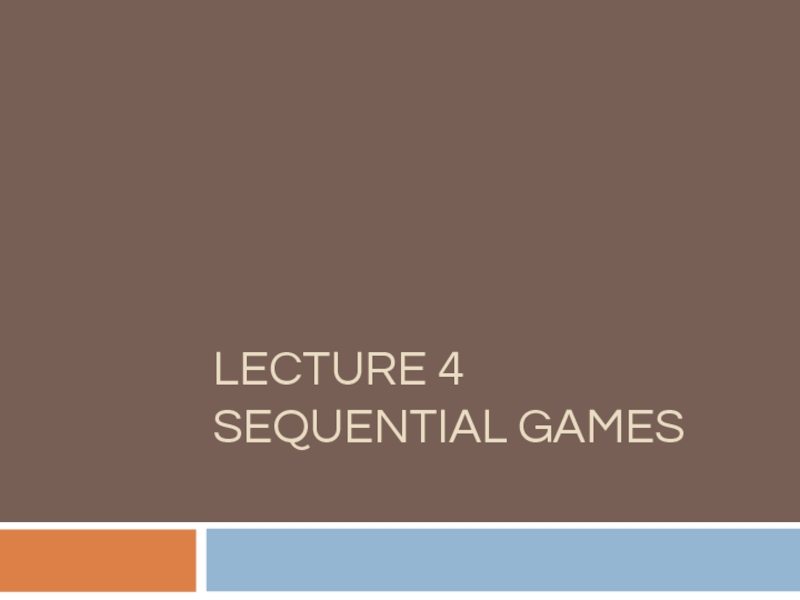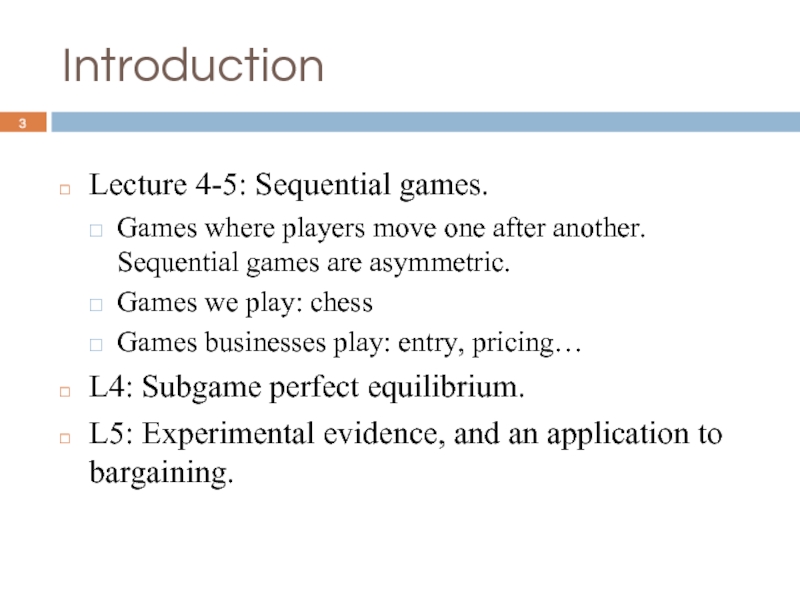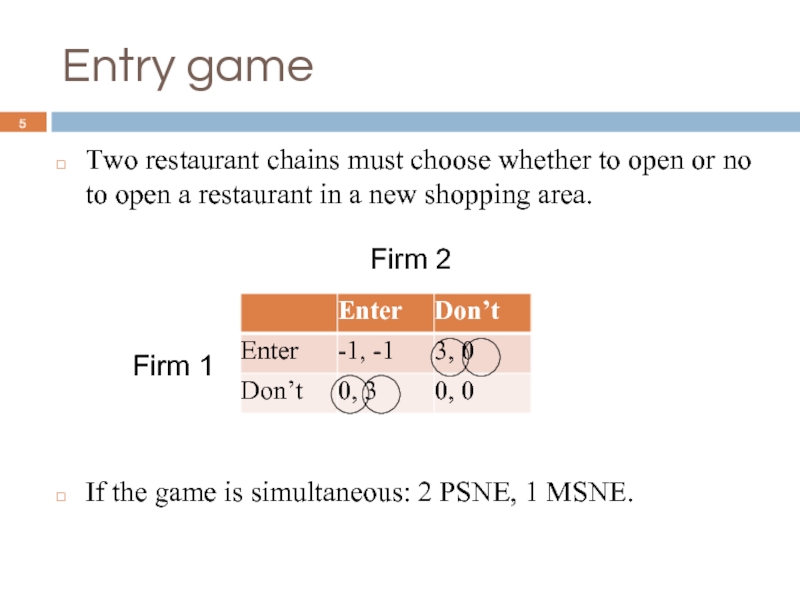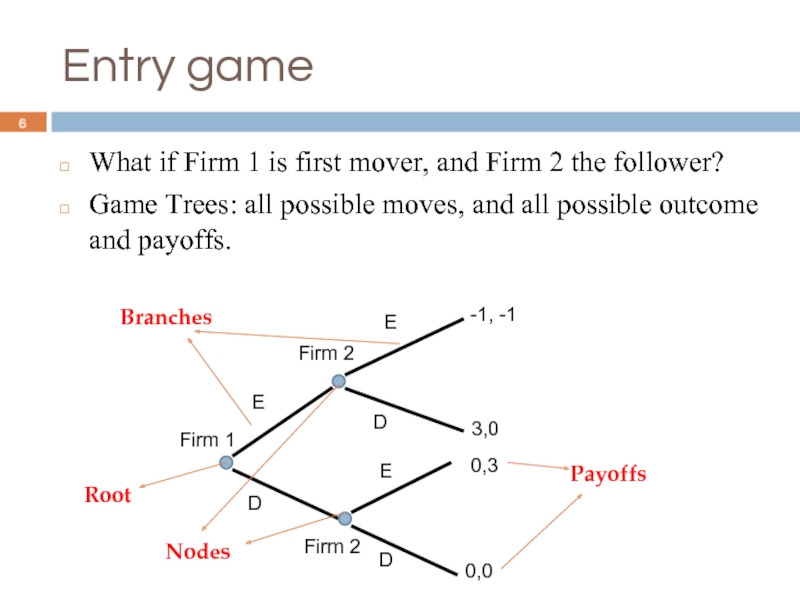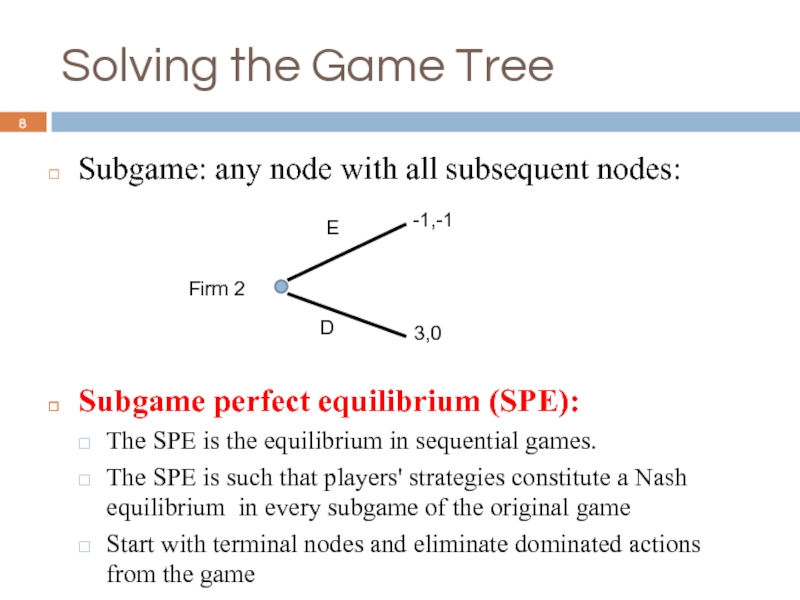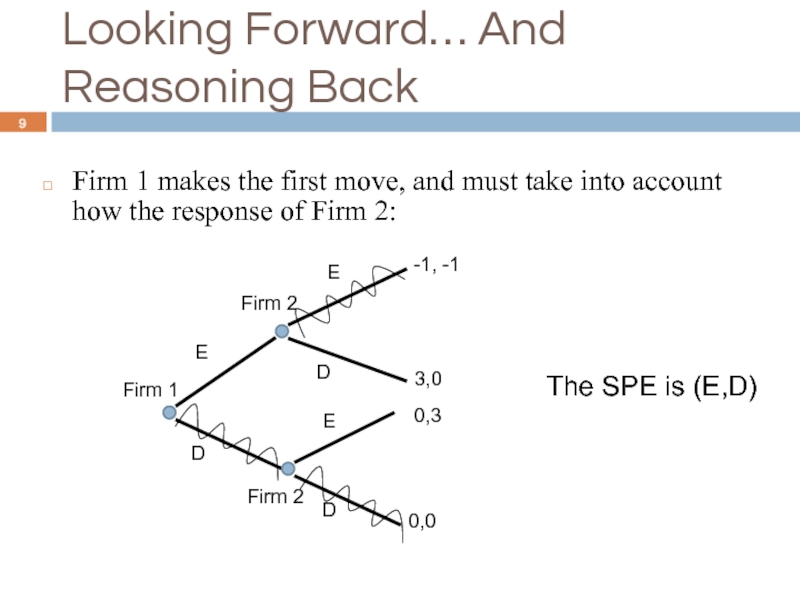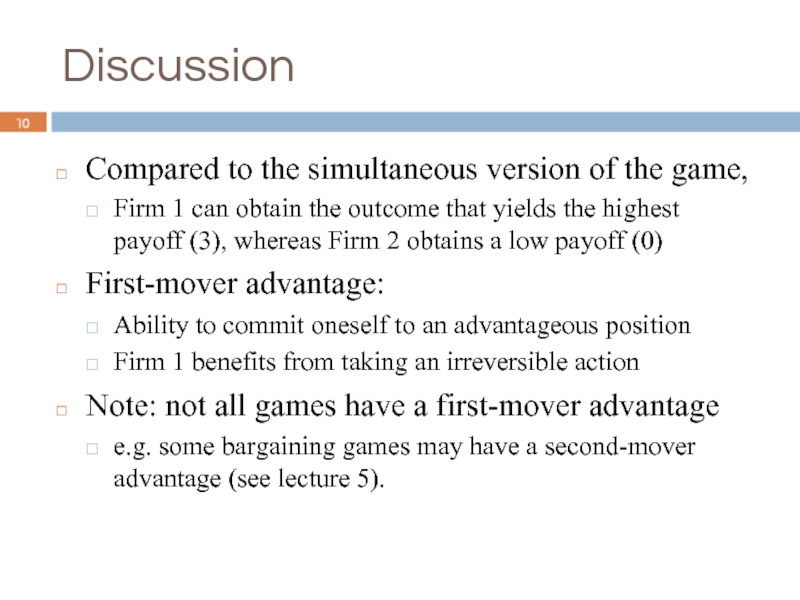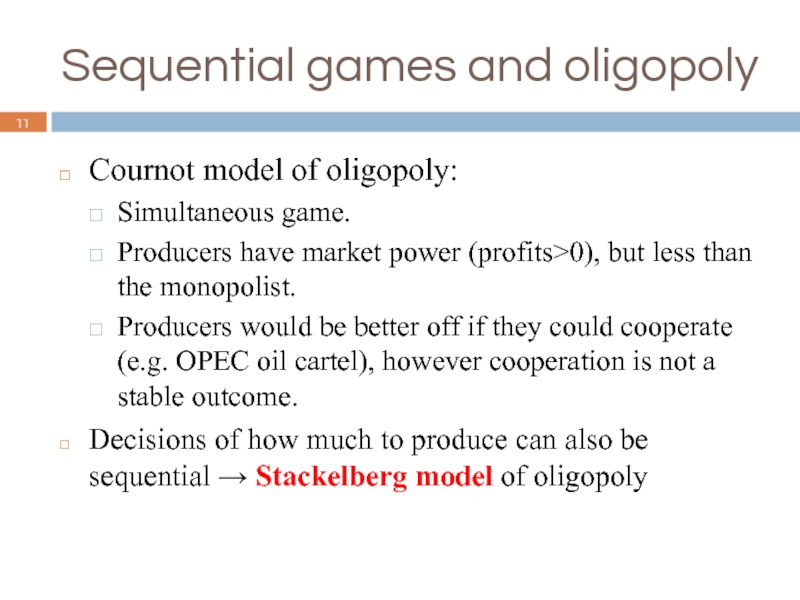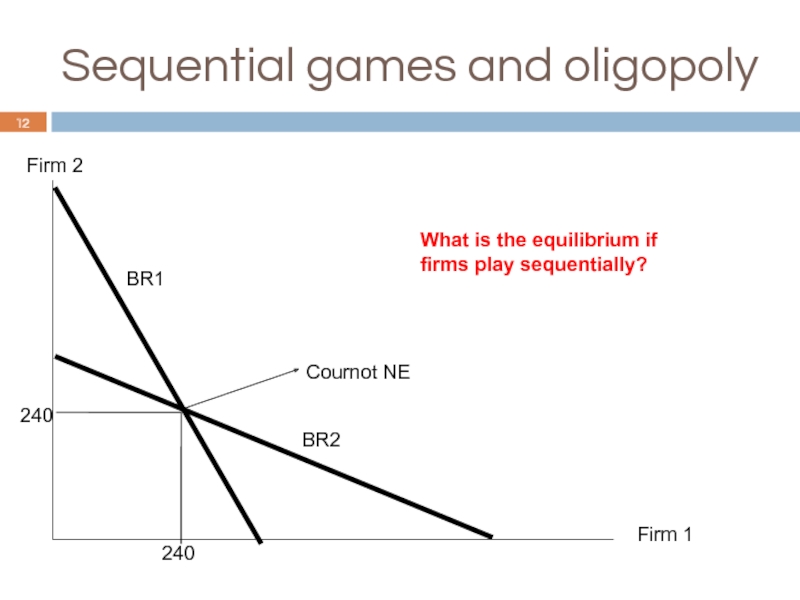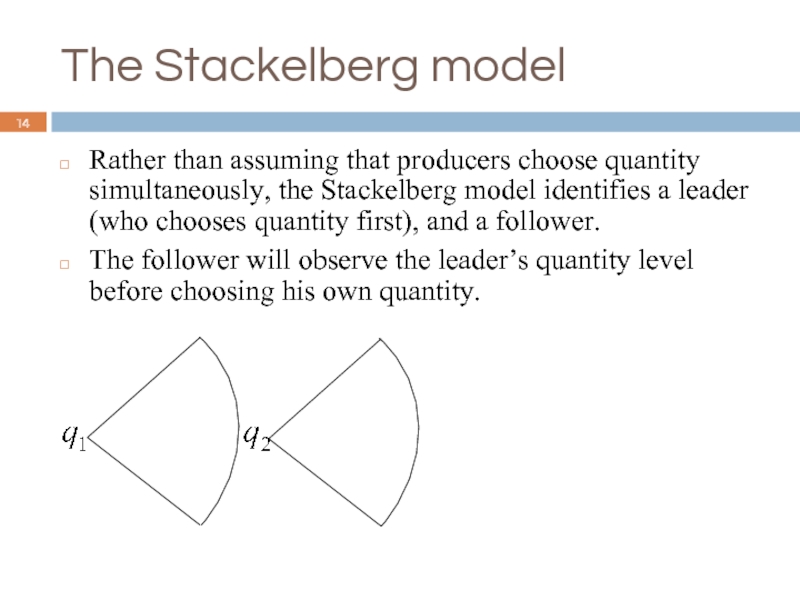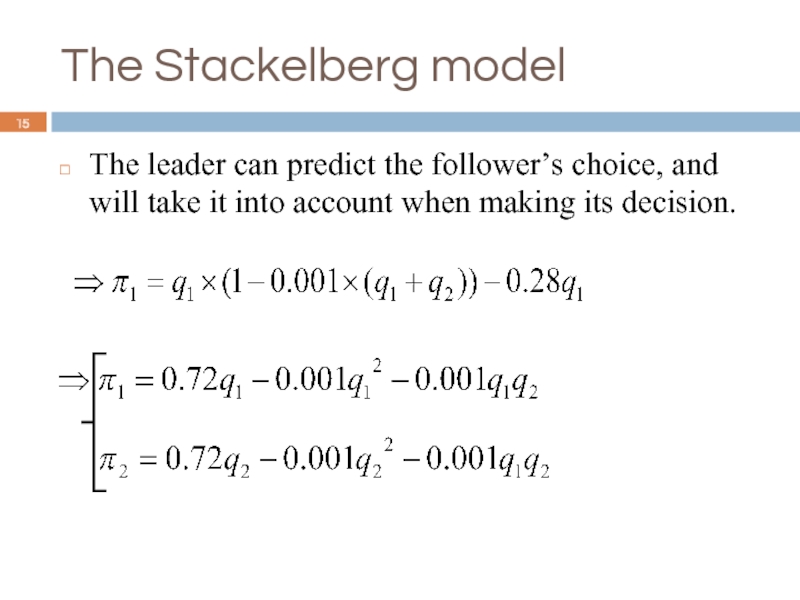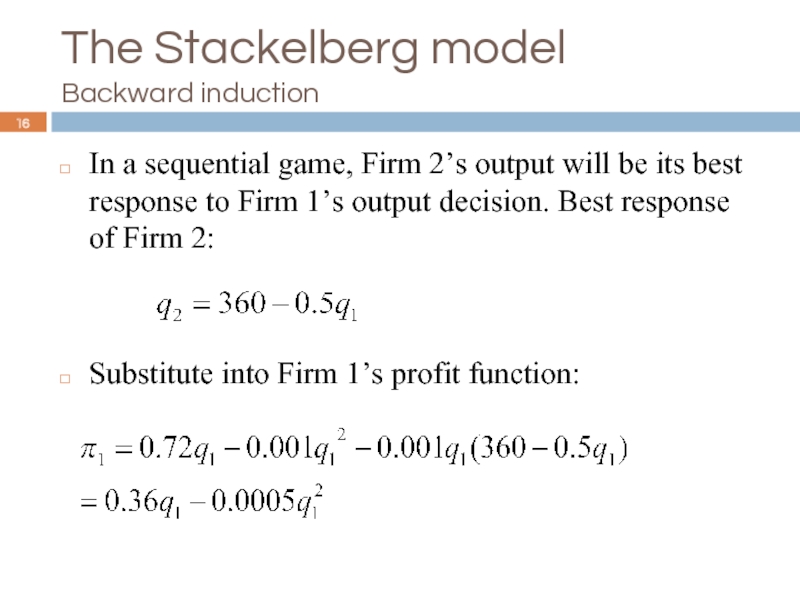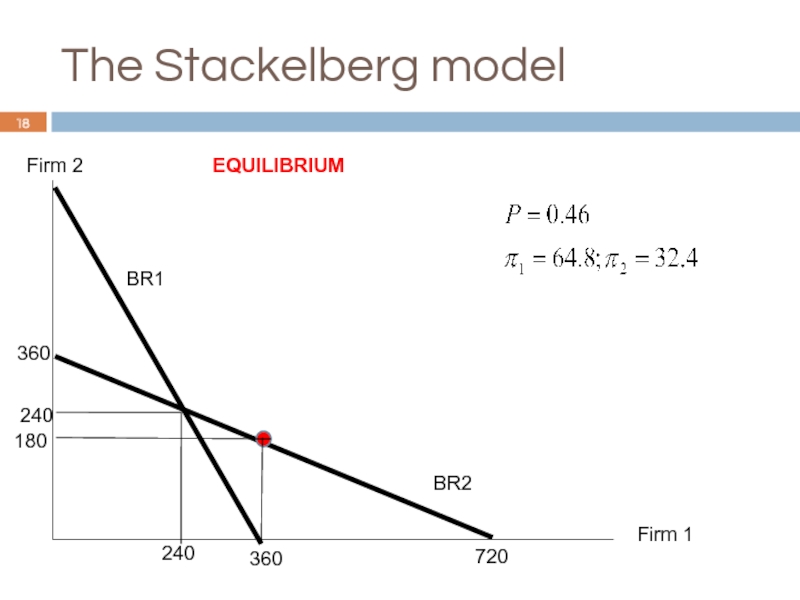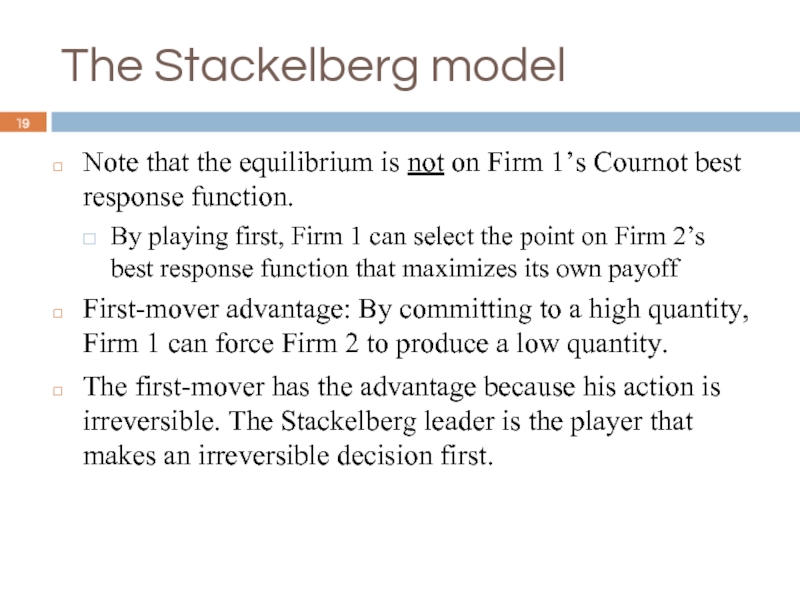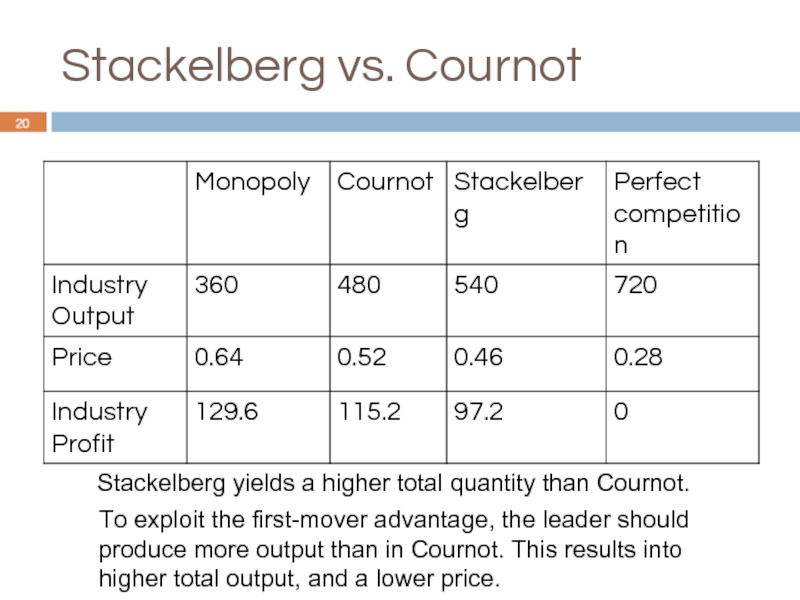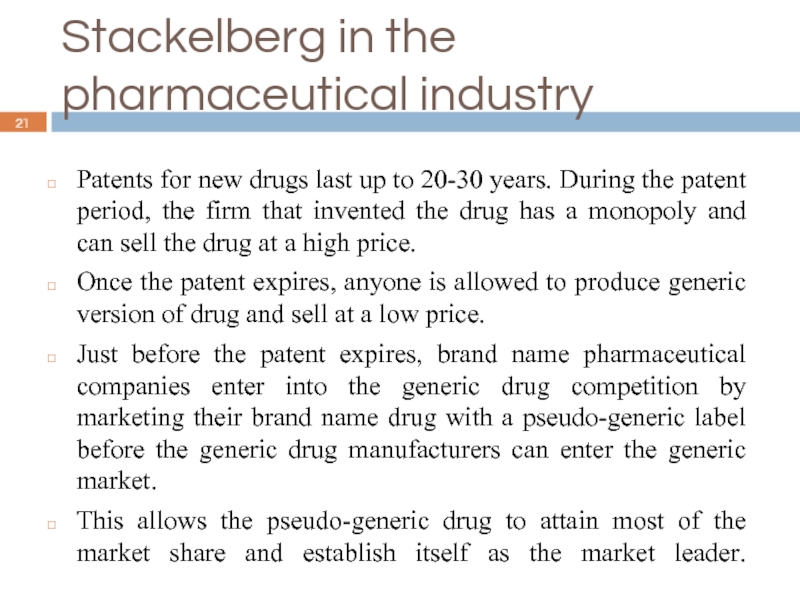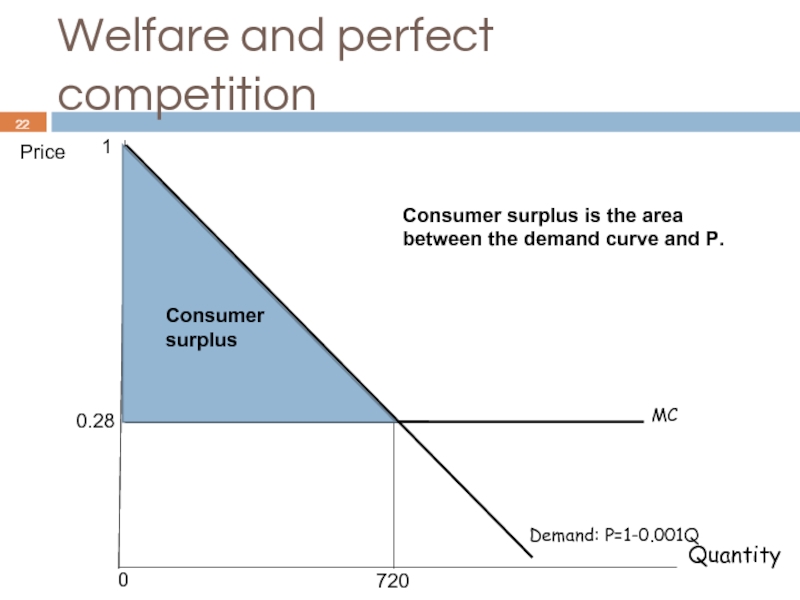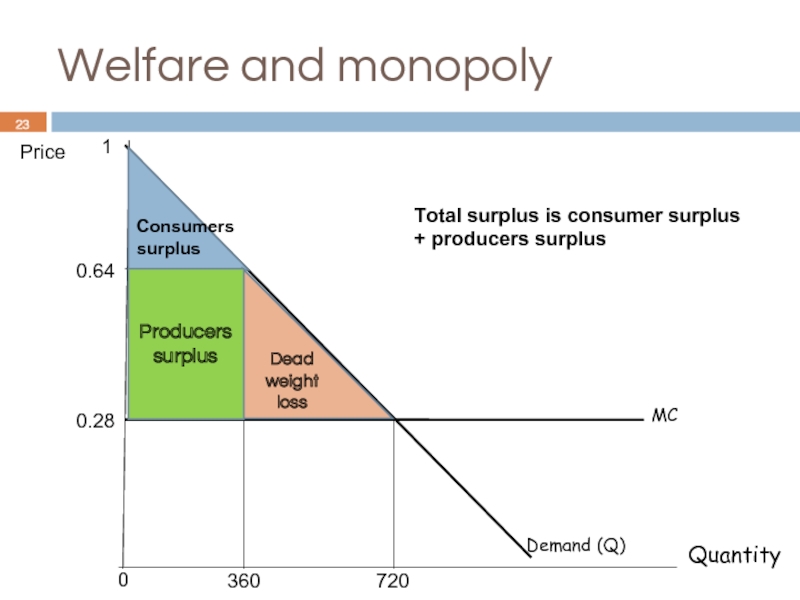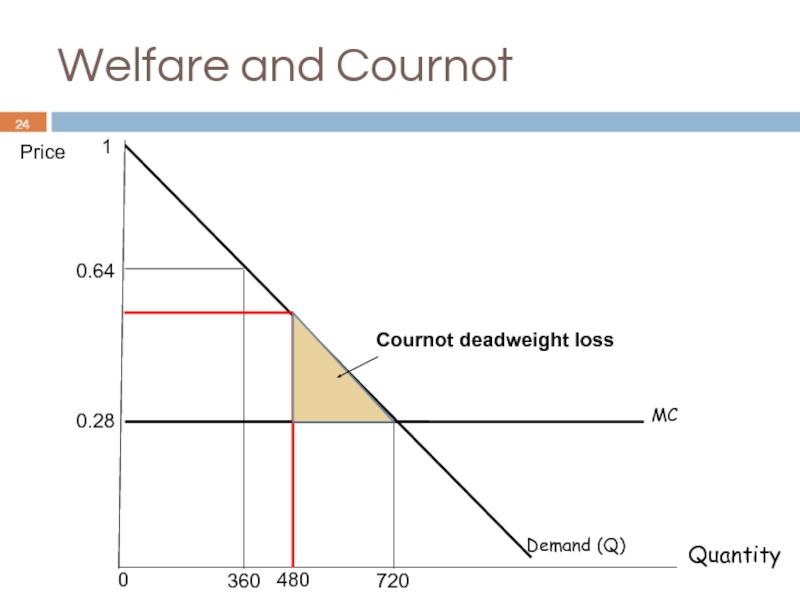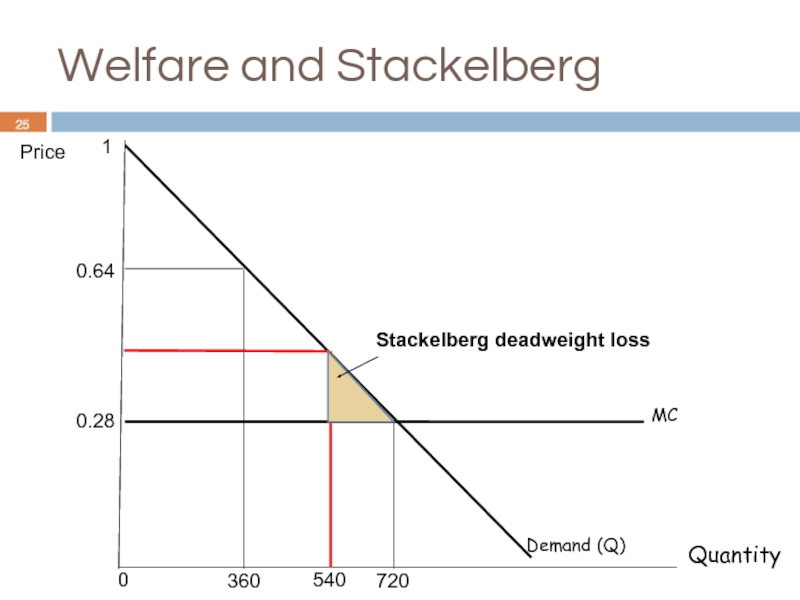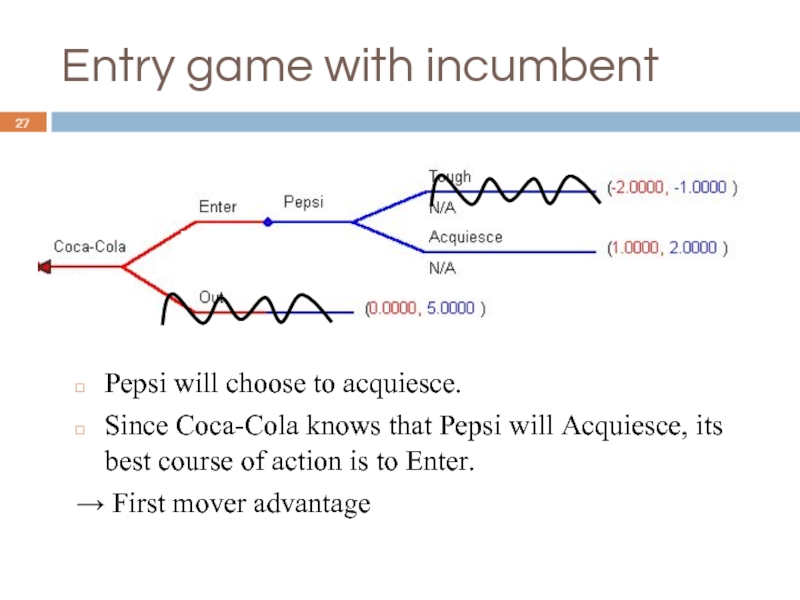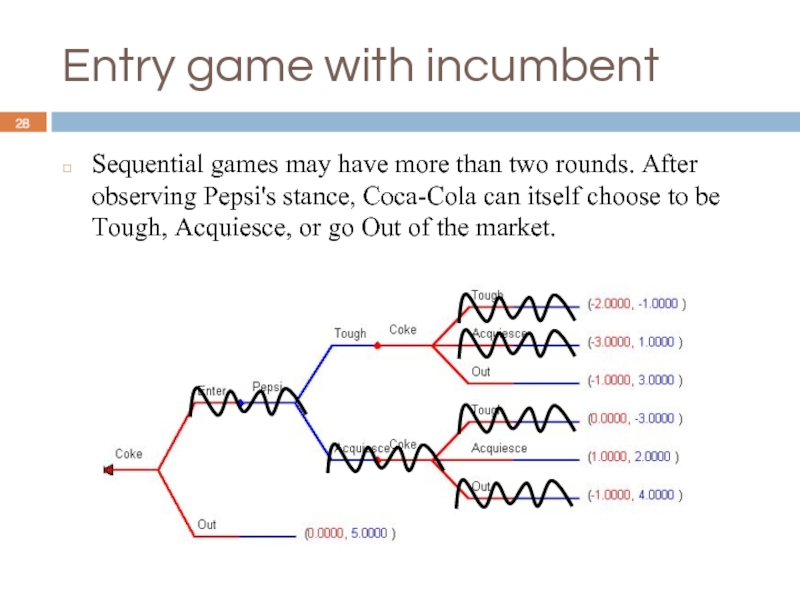- Главная
- Разное
- Дизайн
- Бизнес и предпринимательство
- Аналитика
- Образование
- Развлечения
- Красота и здоровье
- Финансы
- Государство
- Путешествия
- Спорт
- Недвижимость
- Армия
- Графика
- Культурология
- Еда и кулинария
- Лингвистика
- Английский язык
- Астрономия
- Алгебра
- Биология
- География
- Детские презентации
- Информатика
- История
- Литература
- Маркетинг
- Математика
- Медицина
- Менеджмент
- Музыка
- МХК
- Немецкий язык
- ОБЖ
- Обществознание
- Окружающий мир
- Педагогика
- Русский язык
- Технология
- Физика
- Философия
- Химия
- Шаблоны, картинки для презентаций
- Экология
- Экономика
- Юриспруденция
Sequential games. (Lecture 4) презентация
Содержание
- 1. Sequential games. (Lecture 4)
- 2. Introduction Lecture 1-3: Simultaneous games: Prisoner’s dilemma
- 3. Introduction Lecture 4-5: Sequential games. Games
- 4. Sequential games Looking forward: Players, when make
- 5. Entry game Two restaurant chains must choose
- 6. Entry game What if Firm 1 is
- 7. Solving the Game Tree Method use to
- 8. Solving the Game Tree Subgame: any node
- 9. Looking Forward… And Reasoning Back Firm 1
- 10. Discussion Compared to the simultaneous version of
- 11. Sequential games and oligopoly Cournot model of
- 12. Firm 1 Firm 2 Cournot NE BR1
- 13. The Stackelberg model A Cournot game with
- 14. The Stackelberg model Rather than assuming that
- 15. The Stackelberg model The leader can predict
- 16. The Stackelberg model Backward induction In a
- 17. The Stackelberg model Derive the optimal output
- 18. 360 720 Firm 1 Firm 2 EQUILIBRIUM
- 19. The Stackelberg model Note that the equilibrium
- 20. Stackelberg vs. Cournot Stackelberg yields a higher
- 21. Stackelberg in the pharmaceutical industry Patents for
- 22. Price MC 0.28 720 Demand: P=1-0.001Q 1
- 23. 360 Price MC 0.28 0.64 Demand (Q)
- 24. 360 Price MC 0.28 0.64 720 Demand
- 25. 360 Price MC 0.28 0.64 720 Demand
- 26. Entry game with incumbent Suppose that Pepsi
- 27. Entry game with incumbent Pepsi will choose
- 28. Entry game with incumbent Sequential games may
- 29. Entry game with incumbent Coca-Cola looks at
- 30. Strategic moves Players are rational and know
- 31. Strategic moves Threat: A response rule that
- 32. Threat and entry Equilibrium without strategic moves:
- 33. Threat and entry: Credibility problem
- 34. Credible strategic move How to make a
- 35. Credible strategic move How to make a
- 36. Credible strategic move How to make a
- 37. Summary Sequential games Game trees Subgame perfect
Слайд 2Introduction
Lecture 1-3: Simultaneous games:
Prisoner’s dilemma (Ad, No Ad):
Unique PSNE, both
Games without PSNE (shirk/monitor):
MSNE is the intuitive outcome.
Coordination games:
2 PSNE & 1 MSNE. Players may try to coordinate.
Слайд 3Introduction
Lecture 4-5: Sequential games.
Games where players move one after another. Sequential
Games we play: chess
Games businesses play: entry, pricing…
L4: Subgame perfect equilibrium.
L5: Experimental evidence, and an application to bargaining.
Слайд 4Sequential games
Looking forward: Players, when make moves, have to consider how
Reasoning backward: Given other players’ reaction, what is my optimal strategy?
Asymmetry in order of play causes asymmetry in payoffs. It matters who plays first and who plays second.
Слайд 5Entry game
Two restaurant chains must choose whether to open or no
If the game is simultaneous: 2 PSNE, 1 MSNE.
Firm 1
Firm 2
Слайд 6Entry game
What if Firm 1 is first mover, and Firm 2
Game Trees: all possible moves, and all possible outcome and payoffs.
Firm 1
Firm 2
Firm 2
E
E
E
D
D
D
-1, -1
3,0
0,3
0,0
Branches
Nodes
Payoffs
Root
Слайд 7Solving the Game Tree
Method use to solve game tree:
Backward Induction, or
Start from the end, and rollback until the root
Difference with simultaneous game
Drop the concept of joint best response
There is a hierarchy of actions, of players
Слайд 8Solving the Game Tree
Subgame: any node with all subsequent nodes:
Subgame perfect
The SPE is the equilibrium in sequential games.
The SPE is such that players' strategies constitute a Nash equilibrium in every subgame of the original game
Start with terminal nodes and eliminate dominated actions from the game
E
D
-1,-1
3,0
Firm 2
Слайд 9Looking Forward… And Reasoning Back
Firm 1 makes the first move, and
Firm 1
Firm 2
Firm 2
E
E
E
D
D
D
-1, -1
3,0
0,3
0,0
The SPE is (E,D)
Слайд 10Discussion
Compared to the simultaneous version of the game,
Firm 1 can obtain
First-mover advantage:
Ability to commit oneself to an advantageous position
Firm 1 benefits from taking an irreversible action
Note: not all games have a first-mover advantage
e.g. some bargaining games may have a second-mover advantage (see lecture 5).
Слайд 11Sequential games and oligopoly
Cournot model of oligopoly:
Simultaneous game.
Producers have market power
Producers would be better off if they could cooperate (e.g. OPEC oil cartel), however cooperation is not a stable outcome.
Decisions of how much to produce can also be sequential → Stackelberg model of oligopoly
Слайд 12Firm 1
Firm 2
Cournot NE
BR1
BR2
240
240
Sequential games and oligopoly
What is the equilibrium if
firms play sequentially?
Слайд 13The Stackelberg model
A Cournot game with sequential actions
Two producers, Firm 1
Produce the same goods, and sell on the same market.
Слайд 14The Stackelberg model
Rather than assuming that producers choose quantity simultaneously, the
The follower will observe the leader’s quantity level before choosing his own quantity.
Слайд 15The Stackelberg model
The leader can predict the follower’s choice, and will
Слайд 16The Stackelberg model
Backward induction
In a sequential game, Firm 2’s output will
Substitute into Firm 1’s profit function:
Слайд 17The Stackelberg model
Derive the optimal output for Firm 1:
For Firm 2,
Слайд 19The Stackelberg model
Note that the equilibrium is not on Firm 1’s
By playing first, Firm 1 can select the point on Firm 2’s best response function that maximizes its own payoff
First-mover advantage: By committing to a high quantity, Firm 1 can force Firm 2 to produce a low quantity.
The first-mover has the advantage because his action is irreversible. The Stackelberg leader is the player that makes an irreversible decision first.
Слайд 20Stackelberg vs. Cournot
Stackelberg yields a higher total quantity than Cournot.
To exploit
Слайд 21Stackelberg in the pharmaceutical industry
Patents for new drugs last up to
Once the patent expires, anyone is allowed to produce generic version of drug and sell at a low price.
Just before the patent expires, brand name pharmaceutical companies enter into the generic drug competition by marketing their brand name drug with a pseudo-generic label before the generic drug manufacturers can enter the generic market.
This allows the pseudo-generic drug to attain most of the market share and establish itself as the market leader.
Слайд 22Price
MC
0.28
720
Demand: P=1-0.001Q
1
Welfare and perfect competition
Consumer
surplus
Consumer surplus is the area
between the demand
0
Слайд 23360
Price
MC
0.28
0.64
Demand (Q)
1
Welfare and monopoly
Consumers
surplus
Dead weight loss
Producers surplus
Total surplus is consumer surplus
+ producers surplus
0
720
Слайд 26Entry game with incumbent
Suppose that Pepsi (the incumbent) is already in
Pepsi: adopt a Tough defensive response or Acquiesce.
Tough: increase production, fight on prices, advertising campaign etc.
Acquiesce: no aggressive commercial war with Coca-Cola
Слайд 27Entry game with incumbent
Pepsi will choose to acquiesce.
Since Coca-Cola knows
→ First mover advantage
Слайд 28Entry game with incumbent
Sequential games may have more than two rounds.
Слайд 29Entry game with incumbent
Coca-Cola looks at Pepsi's Tough play and should
Pepsi knows that when it plays Tough Coca-Cola will exit. Its best choice is to act Tough to force Coca-Cola to go Out.
Coca-Cola reasons backwards: if it enters, then Pepsi will play Tough and the best response is to go Out. Hence, Coca-Cola’s best play is to Stay Out since it loses 0 instead of -1.
Слайд 30Strategic moves
Players are rational and know how the game will be
Strategic moves: Commitment/threat/promise
Commitment: Commit to take a particular decision unconditionally on the other player’s action.
Having fewer choices is typically worse than having many choices. In sequential games, however, having fewer choices can actually increase your payoff.
Слайд 31Strategic moves
Threat: A response rule that leads to a bad outcome
Promise: A response rule by which you offer to create a good outcome for the other player if he acts in a way that promotes your interests.
Слайд 32Threat and entry
Equilibrium without strategic moves: (Enter,Acquiesce)
What could Pepsi do? Threaten
Rollback: Coca-Cola stays out!
Слайд 33
Threat and entry: Credibility problem
If Coca-Cola enters, it is in Pepsi’s
Pepsi’s threat to be tough if Coca-Cola enters is not credible.
Coca-Cola, knowing that, will enter.
“Talk is cheap”
Слайд 34Credible strategic move
How to make a credible strategic move?
Binding contract between
We will sell you Pepsi at a lower price than Coca-Cola does.
“Tough” becomes credible.
Decide to expand capacity, in order to reduce the marginal costs of increasing quantity.
Keep innovating, in order to commit to improve quality and deter entry.
Слайд 35Credible strategic move
How to make a credible strategic move?
Pepsi can also
Being tough is not subgame perfect, however the entrant may think the incumbent will be tough if he has such a reputation.
If a threat is credible, other firms won’t enter, and the threat to be tough is never materialized.
Слайд 36Credible strategic move
How to make a credible strategic move?
Polaroid instant photography
Refused
In 1976, after 28 years of a Polaroid monopoly on the instant photography market, Kodak entered the fray.
Edwin Land, Polaroid founder:
“This is our very soul we are involved with. This is our whole life…We will stay in our lot and protect that lot.”
